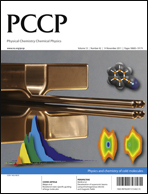A case study in ultracold reactive scattering: D + H2
Abstract
We report theoretical results for reaction and vibrational quenching of the ultracold collision D + H2 (v, j = 0) for a wide range of initial vibrationally excited states v. The v-dependence of the zero-temperature limit of the reaction rate coefficient shows two distinct regimes: a barrier dominated regime for 0 ≤ v ≤ 4, and a barrierless regime for v ≥ 5. We also present detailed distributions over the rovibrational states of the products. We find an approximate conservation of the internal vibrational energy; namely, the branching ratios always favor the highly excited final states, which have vibrational energies similar to that of the entrance channel.

- This article is part of the themed collection: Physics and chemistry of cold molecules

 Please wait while we load your content...
Please wait while we load your content...